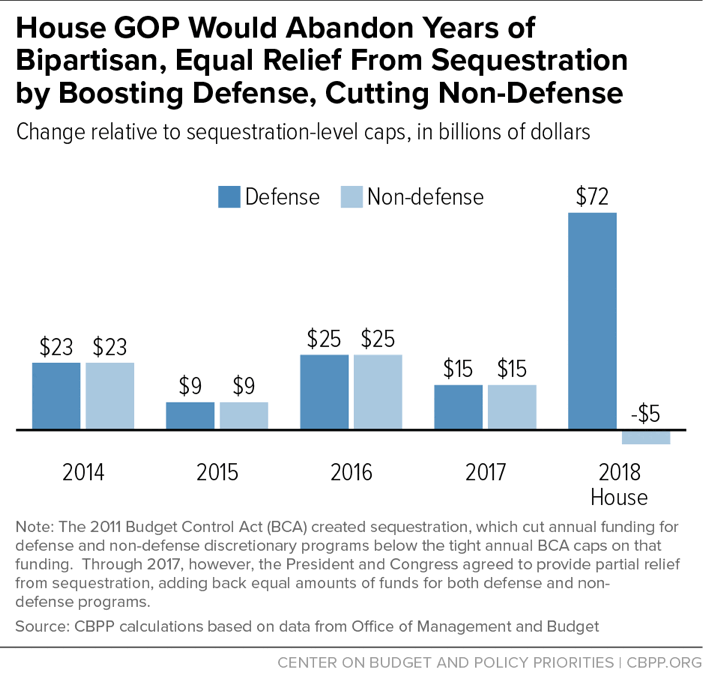- Home
- Abandoning Bipartisan Approach Of Provid...
Abandoning Bipartisan Approach of Providing Equal Relief from Tight Funding Limits, House Republicans Boosting Defense Substantially, Cutting Non-Defense
House Republicans are proposing to treat defense and non-defense discretionary (NDD) programs in a way that would fundamentally alter one of the few areas of bipartisan consensus in recent years, to the detriment of already hard-hit non-defense programs. For several years running, Republican and Democratic policymakers have agreed that the 2011 Budget Control Act (BCA) imposed funding limits that were too tight for both defense and non-defense programs, and agreed to provide equal amounts of relief for both categories. House Republicans are proposing to increase defense funding by $72 billion while cutting NDD funding by $5 billion.But for 2018, House Republicans are proposing to increase defense funding by $72 billion while cutting NDD funding by $5 billion, relative to their BCA limits. The House Appropriations Committee is advancing legislation consistent with these figures, even though the House has yet to adopt a budget.
The BCA funding constraints have already produced deep and painful cuts to a wide range of important NDD programs. NDD funds key investments, including education, medical research, infrastructure, and other programs that help fuel economic growth and raise future living standards, as well as an array of vital public services such as rental assistance, child care subsidies, food safety, veterans’ health care, and environmental protection.
Further, the House GOP’s proposed funding reduction for most NDD programs is much larger than commonly understood. Relative to 2017, NDD programs outside of the Department of Veterans Affairs (which is part of the non-defense budget and has already received a funding increase for 2018) would be cut by $22 billion after adjusting for inflation. These programs would fall to more than one-fifth below their 2010 level, after adjusting for inflation.
Sharp Departure from Equal Sequestration Relief
Defense and non-defense appropriations have been tightly constrained in recent years. The BCA placed binding annual caps on both defense and NDD funding and required additional cuts through a process called “sequestration.” Policymakers have traditionally recognized the need to alleviate the funding constraints for both defense and NDD programs. This year, however, the House would depart sharply from that even-handed approach. As Figure 1 illustrates:
- In fiscal years 2014-2017 both defense and NDD programs received the exact same amount of relief that raised funding above their sequestion-level caps.[1] On average, the annual relief equaled $18 billion for each category.
- If defense is funded at $72 billion above its 2018 sequestration-level cap as proposed, it would receive as much additional funding next year as in the past four years combined.
- When it comes to NDD funding, however, rather than providing sequestration relief, House Republicans are moving forward with a $5 billion cut below the sequestration level. That is, not only would House Republicans leave the NDD sequestration cut fully in place for the first time, they also would require a further cut.
NDD Cuts Outside of Veterans Affairs Substantial Relative to 2017
The House Republicans have set total NDD funding at $511 billion in 2018, $5 billion below the sequestration-level cap, and the House Appropriations Committee is advancing legislation consistent with this overall figure. The true cut to NDD outside of veterans’ programs would be several times larger, however, totaling $22 billion in just one year (after adjusting for inflation). As Table 1 shows:
- Since the 2018 NDD cap is itself $3 billion below the 2017 level, the House approach represents an $8 billion cut relative to 2017, even before considering inflation.
- The House Appropriations Committee has already approved a $4 billion increase in funding for the Department of Veterans Affairs in order to meet rising medical care costs; this step reflects a strong bipartisan priority for Congress.[2] But to stay within the NDD total, policymakers will have to find an equivalent $4 billion in offsetting cuts in other areas.
- To keep pace with inflation, NDD programs would need to increase by $10 billion from 2017 to 2018. Absent this inflation adjustment, the value of the benefits and services provided under the programs will erode.
- Combining all of these factors, NDD programs other than Veterans Affairs would be cut by $22 billion from 2017 to 2018, falling 5 percent below their comparable 2017 level.
| TABLE 1 | |
|---|---|
| House Republican Cuts to Non-Defense Discretionary Funding Outside of Veterans Affairs for 2018 | |
| Cut relative to 2017 | |
| Proposed reduction in NDD funding limit | -$7.5 billion |
| Reduction under current law | -$2.8 billion |
| Further reduction under House GOP plan | -$4.8 billion |
| Cut required to offset increase in Veterans Affairs* | -$3.9 billion |
| Loss in purchasing power due to inflation | -$10.1 billion |
| Total reduction in NDD programs outside Veterans Affairs, adjusted for inflation | -$21.6 billion |
* Increase represents bill approved by House Appropriations Committee.
Note: Figures may not add due to rounding.
Source: CBPP calculations based on data from Office of Management and Budget, Congressional Budget Office, and House Appropriations Committee
Continued NDD Relief Needed, Not Further Cuts
House Republicans’ severe treatment of NDD programs would compound the cuts already made to these programs since 2010.
The proposed NDD funding level for 2018 is 17 percent below the 2010 level, after adjusting for inflation, and 22 percent below 2010 after adjusting for both inflation and population growth. For NDD programs outside Veterans Affairs, proposed 2018 funding would be cut below the 2010 level by more than one-fifth after adjusting for inflation and by more than one-quarter after adjusting for both inflation and population.
Overall, the House GOP approach would push NDD spending to its lowest level on record, measured as a percent of the economy (with data back to 1962).
The new cuts ignore the fact that seven years of austerity have already hindered government’s ability to provide important services, invest in the productivity of the workforce, and meet national needs. For example, current funding for core job training grants is already 19 percent below 2010. Federal child care assistance serves fewer than 1 in 6 eligible children, while rental assistance serves only 1 in 4 eligible households.[3]
The sequestration-level caps alone would require deeper cuts or continued underfunding in important NDD programs. Reducing NDD below the sequestration level would significantly limit the government’s ability to provide essential services to the public and invest in the future of the country. Policymakers should reject the damaging path down which House Republicans have started, and return to the bipartisan path of providing sequestration relief for both defense and non-defense programs.
End Notes
[1] Sequestration relief was also provided in equal amounts in 2013, as part of the two-month delay in sequestration enacted as part of the American Taxpayer Relief Act of 2012 (the so-called “fiscal cliff” bill).
[2] U.S. House of Representatives Committee on Appropriations, “Appropriations Committee Approves Fiscal Year 2018 Military Construction and Veterans Affairs Legislation,” press release, June 15, 2017.
[3] David Reich and Chloe Cho, “Unmet Needs and the Squeeze on Appropriations: Policymakers Should Continue Bipartisan Sequestration Relief,” Center on Budget and Policy Priorities, May 19, 2017, https://www.cbpp.org/research/federal-budget/unmet-needs-and-the-squeeze-on-appropriations.
More from the Authors


